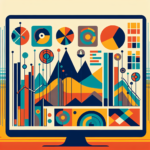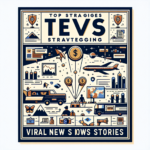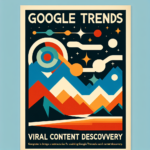Introduction to Identifying Product Trends
Ever wondered how some businesses always appear to be one step ahead of consumer interests? The key lies in the successful identification of product trends. This ability to forecast yet-to-peak trends can ensure a business stays relevant and competitive.
But how does one identify these trends? Is it magic, or is there a more systematic approach to it?
In this guide, we’ll explore the various ways you can spot product trends. From utilizing online tools for trend analysis, studying market psychology, embracing predictive technologies, to analyzing emerging tech influences and cultural trends, it’s an insightful exploration covering a plethora of strategies.
And for those history buffs out there, we’ll also examine how a good, old-fashioned retrospective can often provide the best insights. Wait no more, let’s start right away!
How to Identify Product Trends
Utilizing Online Tools for Trend Analysis
Staying ahead in identifying product trends requires the use of digital tools that offer real-time data and insights. By leveraging these resources, you can spot trends before they peak.
- Google Trends: This tool allows you to see what people are searching for online. By analyzing search volume, you can gauge interest in specific products over time.
- Social Media Platforms: Platforms like Twitter and Instagram can be goldmines for trend tracking. Monitor hashtags and keywords to see what’s gaining traction.
- Trend Prediction Tools: Services like TrendHunter use algorithms and human analysis to predict future trends, providing you with foresight into potential popular products.
Listening to Your Audience
Understanding what your customers want is key to identifying emerging product trends. Here’s how you can do it effectively:
- Customer Surveys: Regularly ask your customers what products they’re interested in through surveys and polls.
- Feedback and Reviews: Pay close attention to customer reviews. Patterns in feedback can help you spot potential trends.
Analyzing Competitor Strategies
Competitors can offer clues about future trends. Keep an eye on their product launches and marketing strategies.
| Strategy | Action |
|---|---|
| Product Launches | Observe new product releases from competitors for potential upcoming trends. |
| Marketing Campaigns | Analyze competitors’ advertising strategies to identify what they predict will trend. |
Using Data and Reports
Aggregating and analyzing industry data can help identify product trends effectively.
- Industry Reports: Reports from reputable firms provide in-depth trend analysis from industry veterans.
- Sales Data: Evaluate your own sales data periodically to spot rising demand for particular products.
For a more detailed analysis, you can check out resources from platforms like Forbes, which often publish insights on industry trends and market analysis.
Attending Trade Shows and Seminars
Being physically present at industry events provides a firsthand look at what’s new and trending.
- Networking Opportunities: Meet industry leaders and gain insights from their experiences.
- Product Displays: See the latest innovations that are being showcased, often hinting at upcoming trends.
Studying Market Psychology for Trend Prediction
Understanding Consumer Behavior
Recognizing consumer behaviors can be a powerful tool in predicting product trends. By understanding why and how consumers make purchasing decisions, you can better anticipate which products will be popular in the future.
- Consumer Spending Patterns: Examining consumers’ spending habits can give you insights into what types of products they are likely to buy in the future.
- Psychographics: Beyond demographic data, understanding consumers’ lifestyle, values, interests, and opinions can help predict potential product trends.
Benchmarking Analysis
Comparing your business operations with those of top-performing competitors helps identify which products are successful in the market.
- Product Comparison: Evaluating your product features against market leaders could uncover areas for improvement that could meet emerging trends.
- Pricing Evaluation: Analyzing how competitors price their products may provide insights into the market’s direction.
Take Advantage of Trend Forecasting in Retail Industry
Predictive Analytics and Machine Learning
More businesses are turning to advanced technologies like predictive analytics and machine learning for trend prediction. These mechanisms analyze large datasets to identify patterns, which can give you an edge in predicting future product trends.
- Predictive Analytics: This uses statistical techniques like data mining and modeling to predict future outcomes; it can be used to forecast customer behavior.
- Machine Learning: This form of AI processes huge amounts of data and learns from it to predict future trends.
In terms of their application in trend forecasting, you could check out resources on IBM to better understand how businesses are using these technologies for anticipating future consumer trends.
Fashion Forecasting
In the retail industry, fashion forecasting is a common practice for predicting product trends.
- Color analysis: Color plays a big role in the fashion industry. By studying color trends, companies can anticipate which hues will be popular in the coming seasons.
- Silhouette trends: Fashion silhouettes change with time. Keeping an eye on these shifts can help predict what clothing styles will be trending next.
E-commerce Data Analysis
With the booming e-commerce sector, analyzing customer behavior online and using sales data from online platforms can fuel anticipation of future trends.
- Online wishlists: Monitoring what customers are saving for later can suggest products that will increase in popularity.
- Shopping cart abandonment analysis: Reviewing what items customers frequently leave behind can provide insights into buyer’s decision-making, helping predict future trends.
How Different Sources Help in Identifying Product Trends
Emerging Technologies as Trend Indicators
In addition to traditional methods, emerging technologies such as AI, blockchain, and IoT can serve as valuable indicators for predicting product trends. These technologies not only shape new business models but also highlight sectors ripe for innovation.
- Artificial Intelligence: Tracks consumer behavior in real-time, personalizing product offerings and enhancing trend prediction.
- Blockchain Technology: Creates transparent and efficient supply chains that can quickly adapt to emerging trends.
- Internet of Things (IoT): Gathers data from smart devices, offering insights into consumer usage patterns and preferences.
Influencer Marketing and Content Creators
Influencer marketing leverages the established trust and reach of online personalities who can quickly set new trends and make products go viral.
- Collaboration with Influencers: Partnering with social media influencers can instantly validate a product’s trend status.
- User-Generated Content: Observing content from content creators can indicate what products or services are gaining popularity.
Local and Cultural Trends
Understanding local and cultural nuances plays a critical role in identifying geographically-specific product trends. These variations can influence product success in different markets.
- Cultural Events: Events such as festivals or national holidays can spur demand for certain products.
- Regional Preferences: Preferences in flavors, styles, or services can highlight emerging trends in specific areas.
Subscription Service Trends
The trends within subscription services can provide insights into changing consumer demands and preferences, indicating profitable niches.
- Monthly Box Themes: The popularity of certain themes might suggest wider market interests.
- Service Offerings: The growth or decline in specific types of subscriptions can reveal consumer priorities.
Regulatory and Economic Shifts
Changes in regulations, economic conditions, and government policies can significantly impact product trends, influencing what products become viable or desirable.
- Regulatory Changes: Policies affecting sustainability could increase the demand for eco-friendly products.
- Economic Indicators: Recessions or economic booms can alter consumer spending habits, affecting trend direction.
For further insights into how technology trends influence the market, you might find resources from TechCrunch useful, as they regularly cover emerging technologies and their market impact.
How to Identify Product Trends
Identifying Trends through Historical Analysis
Looking back at past trends can inform future predictions. Historical analysis involves studying when and why certain products became popular.
- Historical Sales Data: Identifying trends from past sales data can shed light on seasonal or cyclical trends that may recur.
- Market Trend Reports: Use detailed reports to assess how trends developed in the past and the time taken for them to gain popularity.
Leveraging Influencer Relationships
Influencers can provide quick insights into what’s currently popular among consumers. Their reach and engagement with audiences offer clues into potential trends.
- Product Endorsements: Pay attention to what products influencers are endorsing, as this can signal a growing trend.
- Audience Engagement: Analyze the level of audience engagement with influencer content to gauge interest in specific products.
Integrating Regional and Cultural Insights
Different regions exhibit unique cultural trends that can impact product popularity. By understanding these nuances, businesses can better tailor their product offerings.
- Local Market Analysis: Study local consumer behaviors and preferences to spot regional trends.
- Cultural Sensitivity: Incorporate cultural values and norms into product design to appeal to specific markets.
Using Subscription Data for Trend Prediction
Subscription services provide a steady channel for monitoring consumer preferences and evolving product interests.
- Content Insights: Track the themes and contents of popular subscription boxes for emerging trends.
- Customer Feedback: Gather feedback from subscribers to understand evolving needs and potential trend directions.
For additional insights into identifying product trends, consider exploring resources from McKinsey & Company, where they offer research and analysis on market trends and consumer behavior.
Conclusion: Leveraging Insights to Stay Ahead of Product Trends
Identifying product trends is a multifaceted process involving active engagement with several data channels and consumer touchpoints. From utilizing online tools, scrutinizing audience interactions, competitor analysis, studying market psychology, to exploring the role of emerging technologies and local cultural nuances, staying ahead of trends requires holistic criteria.
With the advancement of AI and machine learning, analytics has become more sophisticated, enabling precise trend forecasting. Understanding these trends, aligning them with organizational capabilities, and effectively communicating them to target audiences can profoundly influence product acceptance and success.
Frequently Asked Questions – FAQs
What are the methods to identify product trends?
Product trend identification strategies may include analyzing online search patterns, using social media trend data, studying audience feedback, attentive competitor strategies, analyzing sales and industry data, networking at industry events, and studying marketing psychology.
Is studying market psychology important for predicting product trends?
Yes, understanding consumer behavior can provide valuable insights into predicting product trends. By understanding why and how consumers make purchasing decisions, businesses can anticipate which products will be in demand.
What is the role of AI and Machine Learning in trend forecasting?
AI and Machine Learning can process vast amounts of data to identify patterns, and companies can leverage these insights to predict future trends. From mining customer behavior to tracking sales and spotting recurring patterns, AI plays a critical role in trend forecasting.
Are Influencers and content creators useful for identifying product trends?
Definitely. Influencer marketing and content from creators can be a strong indication of what is gaining traction in the consumer market and what products or services are popular.
Do local and cultural trends play a significant role in product trend identification?
Yes, local and cultural nuances can significantly impact product trends. Understanding these variations can help businesses tailor their product offerings more effectively to different markets.






